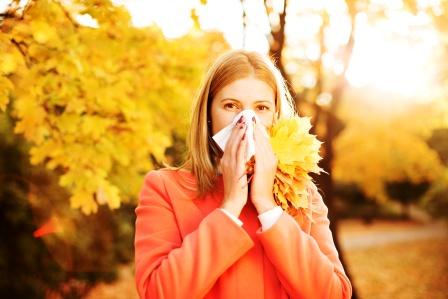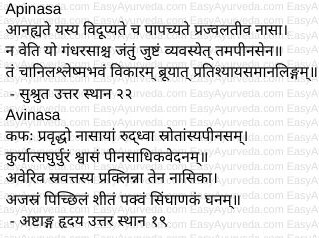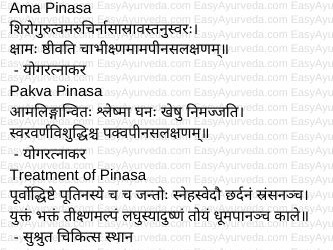Pinasa – Meaning, Symptoms, Treatment
By Dr Raghuram Y.S. MD (Ay) & Dr Manasa, B.A.M.S
Peenasa is one of the most important nasal disorders. It is also called as Apinasa. It either manifests independently or as a consequence / complication of another nasal disorder – Pratishyaya which is often compared to rhinitis. In ancient Ayurveda treatises both these conditions are often used synonymous to each other.
Some authors have even considered pinasa and apinasa as different disease conditions. Peenasa is a condition which develops on the backdrop of / complication of pratishyaya. Apinasa is another independent condition which is similar to Pinasa, develops due to Pinasa and has almost similar symptoms as those of Pratishyaya.
Read – Allergic Rhinitis: Causes, Remedies, Ayurvedic treatment, Herbs
Thus we do not get to see clear differentiation between these two conditions described in the classics in spite of both terms being used. This also gives us an impression that these two conditions are one and the same but given with different names by different authors.
According to Bhavaprakasha treatise both pinasa and apinasa are the same conditions.
Master Vagbhata’s explanation of two conditions pinasa and avinasa (instead of apinasa) gives us a different clarification regarding these two conditions. Avi means sheep, Nasa means nose. According to Vagbhata Avinasa is a condition in which the one’s nose gets stuffy and filled with more phlegm just like the nose of a sheep is filled with phlegm always.
Read – Atrophic Rhinitis: Ayurvedic Treatment, Home Remedies, Herbs, Medicines

Table of Contents
Apinasa
Apinasa is a disease of the nose caused by combined vitiation of vata and kapha. It will present with signs and symptoms similar to those of pratishyaya. Specific symptoms include –
- Anahyate – feeling of fullness in the nose / feeling stuffy
- Vidhupyate – feel as if smoke is being eliminated from the nose
- Vipachyate – formation of pus in the nose
- Prajvalati iva – feel as if the nose is burning
- Na vetti gandha rasascha – loss of perception of sensation of smell and taste
- Jantu jushtam – nose afflicted by worms
Read – Sinusitis: Ayurvedic treatment, Remedies, Preventive tips
Avinasa
Kapha gets increased in the nose and causes blockage in the channels (passages) of the nose and causes a condition called as apinasa / avinasa.
Symptoms include –
- Ghurghurakam Shwasam – added sounds while breathing – as that of wheeze or crepitus
- Pinasadhika Vedana – more pain and discomfort in comparison to pinasa
- Averiva sravati asya praklinna tena nasika – discharges occur from the nose just like from the nose of the sheep and hence the nasal cavity always keeps moist
- Ajasram pichchilam shitam pakvam singhanakam ghanam – nasal discharges which are thick, sticky, cold, mixed with pus and constantly getting discharged from the nose (mucopurulent discharges)
Types, Stages of Peenasa
1. Ama Pinasa / Apakva Pinasa –
It is the stage of the disease in an immature / unripe form. The symptoms include –
- Shiro gurutva – heaviness of the head
- Aruchi – tastelessness
- Nasa srava – discharges from the nose
- Tanu swaraha – thinning of voice
- Kshama – debility
- Shtivanam cha abhikshnam – continuous / repeated spitting
2. Pakva Peenasa –
It is the stage of the disease in its mature / ripened form. The symptoms include –
- Shleshmaa ghanah kheshu nimajjati – the mucus / secretions get thickened and blocks the nasal passages
- Swara varna vishuddhih – voice and color becomes clear
Read – 4 Remedies For Morning Sneezing With Turmeric, Black Pepper, Tulsi
Treatment of Pinasa / Apeenasa
- Oleation
- Sudation
- Emesis
- Purgation / laxative
- Bhaktam tikshnam alpam laghu syat – food less in quantity, light to digest and penetrative in property
- Hot water
- Dhumapanam cha kale – medicated smoking in proper time
- Avapidana – kind of nasal medication in which the medicines are pressed into the nostrils
Medicinal Yogas for Pinasa from Sahasra Yoga Text book
Tulasi swarasadi Taila
Sahacharadi Taila
Kacchuradi Choorna (Brihat)
Nasika Choorna
Narasimha Choorna
Agasthya Rasayana
Bahusala Guda
Cherupayaradi Kashaya
Sanskrit Verses


Useful formulations
1. External therapies
Hingvadi Avapidana – the below mentioned herbs should be ground and their juice pressed into the nostrils. Alternatively the powder of these ingredients should be given for snuffing –
- Hingu – asafetida / Ferula narthex
- Trikatu – Piper longum, Piper nigrum and Zingiber officinale
- Punarnava – Boerhavia diffusa
- Laksha – Laccifer lacca
- Tulasi bija – seeds of Ocimum sanctum
- Katphala – Myrica esculenta
- Vacha – Acorus calamus
- Kushta – Saussurea lappa
- Shigru – Moringa oleifera
Kalingadi Avapidana – juice of the below mentioned should be instilled into the nostrils of the patient –
- Kalinga – seeds of Holarrhena antidysenterica
- Asafetida
- Black pepper
- Laksha – Laccifer lacca
- Katphala – Myrica esculenta
- Kushta – Saussurea lappa
- Vacha – Acorus calamus
- Shigru – Moringa oleifera
- Vidanga – Embelia ribes
Read – First Thing To Do In Allergy Attack- How I stopped My Daughter’s Cough
Madhuchishtadi Dhuma – Smoke coming from burning the below mentioned ingredients should be inhaled –
- Bee wax
- Guggulu – Commiphora mukul
Shatahvadi Dhuma – the below mentioned should be burnt together and the smoke inhaled –
- Shatahva – Anethum sowa
- Cinnamon
- Bala mula – roots of Sida cordifolia
- Shyonaka – Oroxylum indicum
- Erandamula – roots of Ricinus calamus
- Bilva – bark of Aegle marmelos
- Aragvadha – resin of Cassia fistula
- Vasa – muscle fat
- Ghee
- Bee wax
Yavanyadi Nasya – the below mentioned herbs should be crushed, tied in a bolus, heated on the pan and the smoke coming from it should be inhaled –
- Yavani – Trachyspermum ammi
- Agnimantha – Premna integrifolia / Clerodendrum phlomidis
- Vacha – Acorus calamus
- Cumin
- Kalajaji – Nigella sativa
Pathadi Taila Nasya – nasal drops should be instilled using the oil prepared with the below mentioned ingredients –
- Patha – Cissampelos pareira
- Turmeric
- Daruharidra – Berberis aristata
- Pippali – Piper longum
- Murva – Marsdenia tenacissima
- Jasmine leaves
Shigru Taila Nasya – nasal drops should be instilled using the oil prepared with the below mentioned ingredients –
- Seeds of Moringa oleifera
- Seeds of Solanum xanthocarpum
- Seeds of Croton tiglium
- Leaves of Aegle marmelos
Read – 6 Simple Home Remedies To Stop Runny Nose
2. Internal medication
Maricha-Guda – In all kinds of pinasa, black pepper and Jaggery should be consumed with curds.
Panchamuli Ksheera – Milk processed with Brihat Panchamula – 5 greater roots should be prescribed. The roots of the below mentioned herbs shall be taken –
- Bilva – Aegle marmelos
- Agnimantha – Clerodendrum phlomidis
- Shyonaka – Oroxylum indicum
- Patala – Stereospermum suaveolens
- Gambhari – Gmelina arborea
Chitraka-Haritaki siddha ksheera – Milk processed with Chitraka – Plumbago zeylanica and Haritaki – Terminalia chebula should be prescribed.
Vidanga Kwatha – decoction prepared with Vidanga – Embelia ribes mixed with ghee and jaggery should be served.
Godhuma – Preparations made by cooking together of wheat flour, ghee and jaggery is good.
Vidanga Shashkuli – Large round pancake prepared with powder of Vidanga – Embelia ribes mixed with wheat flour helps as good remedy and diet for patients of pinasa. While on this diet, the person should drink cold water at bedtime.
Katphaladi Churna / Kashaya – Decoction or powder prepared using the below mentioned herbs shall be prescribed –
- Katphala – Myrica nagi
- Pushkaramula – Inula racemosa
- Trikatu – Piper longum, Piper nigrum and Zingiber officinale
- Yavasa – Alhagi camelorum
- Shatapushpa – Anethum sowa
Vyoshadi Vati – tablets should be used for sucking.
Tentative modern comparison
There are many nasal diseases explained in modern texts which resemble the explanation of symptoms of Pinasa / Apinasa but the condition explained in Ayurveda can be very closely compared to ‘Atrophic Rhinitis’.
Click to Consult Dr Raghuram Y.S. MD (Ayu)









